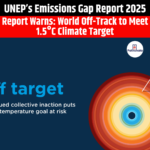India’s Retail Inflation Falls to 8-Year Low in September 2025
|
General Studies Paper III: Growth & Development, Fiscal Policy |
Why in News?
India’s retail inflation dropped to an 8-year low of 1.54% in September 2025, marking a major economic relief of cooling price pressures and improving supply stability across essential food items.
Highlights of India’s Retail Inflation Fall
- India’s retail inflation dropped to an eight-year low of 1.54% in September 2025, showing a remarkable decline not seen since June 2017. This figure reflects a major improvement in price stability after months of controlled inflation trends.
- The inflation rate in August 2025 was 2.07%, and the September figure of 1.54% confirmed a steady cooling pattern across several major sectors. This consistent decline shows that the price pressure on households is easing.
- In September 2024, India recorded retail inflation of 5.49%, which was significantly higher than the current level. The difference between last year’s and this year’s data highlights the impact of better supply conditions and efficient price management.
- According to the National Statistics Office (NSO), rural inflation stood at 1.07%, while urban inflation was slightly higher at 2.04%. The data shows that both rural and urban regions are experiencing a balanced inflation environment.
- Inflation in fuel and light slowed to 1.98% in September 2025, down from 2.43% in August. This reduction indicates a steady decline in energy-related expenses, helping households manage utility costs.
RBI’s Inflation Target and Monetary Policy
- The Reserve Bank of India (RBI) follows an inflation-targeting framework to ensure price stability and support economic growth. Its medium-term target is to keep Consumer Price Index (CPI) inflation at 4%, with a tolerance band of 2% on either side. This means inflation should ideally remain within the 2–6% range.
- The RBI uses several monetary policy tools such as the repo rate, reverse repo rate, and cash reserve ratio (CRR) to influence inflation in Monetary Policy Committee Meeting. When inflation rises, the RBI increases the repo rate to make borrowing costlier, thereby reducing money supply in the economy.
- During its October 2025 Monetary Policy Committee (MPC) meeting, the RBI decided to maintain the policy repo rate, observing that the current low inflation trend gives room for future rate cuts if required.
- In October 2025, the RBI revised its inflation projection for FY2025–26 to 2.6%, down from 3.1% estimated in August. The revision was based on the sharp drop in food prices and improved supply conditions across key sectors.
- The RBI expects inflation to stay low through most of FY2026, with quarterly estimates of 1.8% in Q2 and Q3, and a moderate rise to 4% in Q4. The RBI believes that a favourable monsoon, better agricultural output, and stable global commodity prices will help maintain this low inflation trajectory.
Key Factors Behind the Decline in Inflation
- Fall in Food Prices: The most important reason behind the decline in inflation was the sharp fall in food prices across major categories. In September 2025, food inflation stood at -2.28%, showing that prices of several essential items became cheaper compared to last year. Vegetable prices fell by more than 21%, while pulses, fruits, and edible oils also recorded consistent declines.
- Favorable Base Effect: The base effect played a major role in keeping inflation low during September 2025. In 2024, inflation was unusually high at 5.49% during the same month. This created a strong statistical base that made the current year’s inflation appear softer when compared year-on-year. This was already visible in August 2025, when inflation eased to 2.07% before dropping further in September.
- Improved Supply Management: A strong agricultural performance in 2025 helped maintain stable food supplies and lower prices. The southwest monsoon performed well across most states, leading to higher kharif crop output. Adequate reservoir levels and buffer stock management of grains also ensured smooth market supply. The government’s efforts to strengthen rural logistics and reduce post-harvest losses contributed to steady prices of cereals, pulses, and vegetables.
- Decline in Fuel Prices: A decline in fuel and light prices was another factor that reduced overall inflation in September 2025. The inflation rate for this category dropped to 1.98%, reflected stable global crude oil prices and reduced domestic fuel taxes. Lower energy costs decreased transportation and production expenses for industries, helping keep retail prices under control.
- Policy Measures: The government has implemented several tax and supply-side reforms to support price stability. GST rate rationalisation and lower taxes on essential goods like soaps, vehicles, and packaged foods have helped reduce price pressures. The coordination between fiscal and monetary policies has ensured that inflation remains within manageable limits.
Challenges to Inflation Stability in India
- Volatility in Food Prices: Food accounts for nearly 50% of the Consumer Price Index (CPI) in India, so any fluctuation directly impacts overall inflation. Even though food inflation was -2.28% in September 2025, such a trend can change quickly due to unpredictable factors like, weak monsoon season, poor harvest output, or pest attacks.
- Global Oil Prices: India imports more than 80% of its crude oil, which means global oil price fluctuations strongly affect domestic inflation. Any rise in global crude prices immediately increases transportation costs, manufacturing expenses, and energy tariffs. This effect spreads through the economy, raising prices of essential goods and services.
- Geopolitical Risks: Global trade tensions and tariff-related policies are another challenge to maintaining stable inflation. In 2025, the United States imposed tariffs of up to 50% on Indian goods, which affected export competitiveness and could influence domestic production costs. Trade restrictions often lead to supply chain disruptions that raise input prices for industries.
- Fluctuations in Core Inflation: While headline inflation has fallen, core inflation—which excludes food and fuel—remains an area of concern. Unlike food or energy prices, core inflation reflects deeper structural pressures in the economy. High housing rents, healthcare charges, and education fees can keep this component elevated.
|
What is Retail Inflation?
|
|
Also Read: India’s CPI Retail Inflation Rises to 2.07% in August 2025 |









